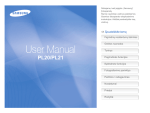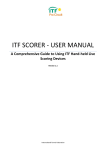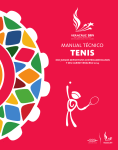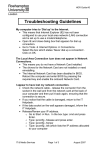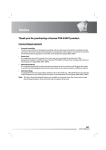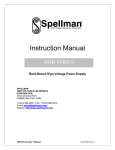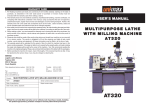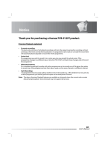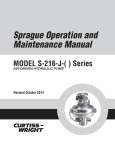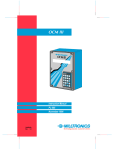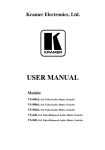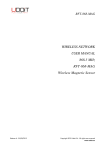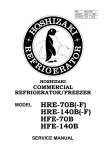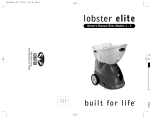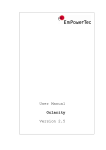Download ITF PAT Approval procedures
Transcript
PROCEDURES FOR OBTAINING 2015 ITF APPROVAL OF PLAYER ANALYSIS TECHNOLOGY 1. INTRODUCTION This document describes the procedures for companies who are involved in the manufacturing or marketing of Player Analysis Technology (“PAT”) and who require ITF Approval of their products. The Rules of Tennis (the “Rules”) state that any PAT to be used in a tournament which is played according to the Rules must be named on the list of such products which have been tested and Approved as conforming to the specifications laid down in Appendix III of the Rules (see Appendix A of this document). PAT is equipment that enables the collection and analysis of information about player performance in real time (or close to it). PAT products are typically either: a. Integrated systems – sensors attached to, or incorporated within equipment that is (designed to be) used by, the player on the court, e.g. inertial sensors, heart-rate monitors. b. Remote systems – sensors that operate without physical connection to the players or their equipment, e.g. video cameras, radars. PAT is permitted for use during competition, but with the following restrictions and conditions: 1. Players’ access to information shall be consistent with Rule 30 (Coaching) of the Rules. That is, players shall not have access to data during a match, except while play is suspended or at certain times in team events1. 2. Information shall be protected from unauthorised access. 3. Information shall be made available to the ITF at its request, for the purposes of regulation, and monitoring the state of the game. These restrictions and conditions define the characteristics of PAT assessed by the approval programme. That is, the communication of data must be: Defined. What data are communicated and how is it done, e.g. wirelessly transmitted from a data logger to a wristwatch that displays graphical information to the user? What are the hardware, software and/or firmware components, and communication protocols used by the system? Switchable. The communication of data to the player must be switchable between accessible and inaccessible. This will commonly be achieved by preventing players’ access to the user interface (at times when coaching is not permitted). Hence, a detailed description of the user interface is necessary. Secure. Who is able to access the data? How will this be controlled, e.g. passkey authentication and data encryption? Note: ITF Approval does not attempt to, nor does it in fact, establish the accuracy or reliability of data or fidelity of its transmission. 1 In addition, sanctioning bodies may apply to the ITF to have on-court coaching allowed (see Appendix A). 2015 ITF PAT Approval procedures, rev. 0: April 2015 PAGE 1 of 11 2. PAT APPROVAL PROCEDURE The PAT Approval process is depicted in figure 1: START Submit application form to the ITF Product added to Approved list REJECTED Application reviewed by the ITF ACCEPTED Receive report from the ITF ACCEPTED Send product and payment to the ITF Product tested by the ITF Figure 1. PAT Approval process flow diagram. i. ii. iii. iv. v. vi. vii. viii. The company applying for Approval (the “Applicant”) completes and submits the form provided in Appendix B (available separately to this document). Supporting material may be emailed (either as attached files or a link to download files) or sent on a CD/DVD/USB flash drive. An invoice for the review of the application form (the “Application Fee”) is sent to the Applicant. The application is reviewed by the ITF, during which time the Applicant may be asked further questions on their product. The ITF informs the Applicant whether their application form has been accepted or rejected, following receipt of payment of the Application Fee. If the application form is rejected, the Applicant can make changes, as necessary, to their product and resubmit their application and Application Fee, i.e. recommence the process at stage (i). If the application form is accepted, the Applicant submits a product sample to the ITF for testing. The sample remains the property of the ITF. Note: Where the product cannot be delivered to the ITF, the Applicant shall arrange for the system to be tested by the ITF Technical Centre in-situ. An invoice for testing the product (the “Testing Fee”) is sent to the Applicant. The ITF tests the product, during which time the Applicant may be asked further questions on their product. The ITF issues the Applicant with a report on the testing stating whether the product has passed or failed the approval process, following receipt of payment of the Testing Fee. If the product is not approved, the Applicant can submit a new application, i.e. recommence at stage (i). 2015 ITF PAT Approval procedures, rev. 0: April 2015 PAGE 2 of 11 ix. x. xi. If the product is approved, it is added to the ITF Approved list on the ITF website and the Applicant is provided with the ITF Approved logo to use in their marketing. ITF Approval is for the lifetime of the product, unless functional changes are made to the software and/or firmware, i.e. ‘major number’ updates, in which case the Applicant must reapply for approval. In this instance, the original application form can be used with revisions identified by adding the text “[change]” at the end of the relevant section(s). The updated software and/or firmware are sent to the ITF. An invoice for the review of the changes (the “Version fee”) is sent to the Applicant. Note: If the product hardware is modified, the Applicant must apply for ITF Approval of a new product, i.e. recommence at stage (i). The ITF informs the Applicant whether the revised product is approved or not, following receipt of payment of the Version Fee. 3. TESTING ORGANISATION Testing of PAT systems for ITF Approval is only carried out by the ITF Technical Centre. National Associations are not authorised to give approval on behalf of the ITF. 4. FEES The cost of PAT Approval is as follows: 1. Application Fee = US$1,000. 2. Testing Fee = US$5,000. 3. Version Fee = US$1,000. ITF Foundation members receive a 10% discount on the above fees. Information on membership of the ITF Foundation may be obtained from the ITF Technical Centre. Where testing of the system is conducted in-situ, the Applicant will be charged reasonable expenses (travel, accommodation and subsistence). Note: Fees for ITF Approval are subject to revision. 5. NOTIFICATION OF RESULTS The ITF Technical Centre will endeavour to inform the Applicant of the result of their submission within the following times: 1. Review of initial application: Two weeks from receiving a completed application form and supporting information, and payment of the Application Fee. 2. Approval testing: Three weeks from receiving a sample/attending a demonstration of the system and payment of the Testing Fee. 3. Version testing: Two weeks from receiving notice of revisions and payment on the Version Fee. 6. PUBLICATION OF THE ITF APPROVED LIST The list of ITF Approved PAT products will be published and regularly updated on the ITF website, www.itftennis.com/technical, and will include a link to a photograph of the product and packaging (where applicable) and to the Applicant’s website. 2015 ITF PAT Approval procedures, rev. 0: April 2015 PAGE 3 of 11 7. USE OF THE “ITF APPROVED” LOGO The Applicant is entitled to use the words “ITF Approved” on the packaging of all products that have been tested and approved. The ITF shall not permit the use of the ITF logo without the word “Approved”. The word “Approved” must be shown either underneath the ITF logo or to the right of the logo, as indicated below. The logo shall be printed in black, white or one single colour. When printed in two colours, the Pantone colours green PMS 340 and yellow PMS 109 shall be used. The logo shall not be more than 2 cm in height or 4 cm in width. The artwork is available from the ITF Technical Centre upon request. Whilst the inclusion of the ITF Approved logo on packaging is not mandatory, the ITF encourages its use. 8. PROVISION OF INFORMATION TO THE ITF The Applicant shall provide the ITF with information generated by all products that have been tested and approved at the request of the ITF. Information shall be provided in a timely manner and in a legible format. Any proprietary software necessary to read the information shall be provided. Permitted methods of file transfer can be requested from the ITF Technical Centre. 9. QUESTIONS AND ANSWERS Q1. Does each variant of a generic/third-party user interface, e.g. smartphone, require ITF Approval? A1. No, generic user interfaces are not approved individually, but an example device must be provided (either by submitting a sample or by naming a suitable device) as part of the approval process, to test the operation of the PAT system. Q2. Does third-party software designed to be used with the PAT system need ITF Approval? A2. Yes, if it is able to be used during a match. Q3. Does a player need to declare whether they intend to use PAT prior to the start of a match? A3. Players may be requested to list the PAT(s) that they are intending to use on their tournament entry form, to enable tournament officials to check if the PAT is approved in advance of the match. Q4. Can a PAT system transmit data during the match? A4. Yes, providing that such data cannot be accessed by the player(s) during the match, except when coaching is permitted. Q5. What is the penalty for using PAT that is not approved? A5. Offences and associated penalties are determined by the sanctioning body of the event and listed in their respective rulebooks. 2015 ITF PAT Approval procedures, rev. 0: April 2015 PAGE 4 of 11 APPENDIX A – EXTRACT FROM RULES OF TENNIS 2015 Please note that where amendments are made in these Regulations the text is underlined. 30. COACHING Coaching is considered to be communication, advice or instruction of any kind and by any means to a player. In team events where there is a team captain sitting on-court, the team captain may coach the player(s) during a set break and when the players change ends at the end of a game, but not when the players change ends after the first game of each set and not during a tie-break game. In all other matches, coaching is not allowed. Case 1: Is a player allowed to be coached, if the coaching is given by signals in a discreet way? Decision: No. Case 2: Is a player allowed to receive coaching when play is suspended? Decision: Yes. Case 3: Is a player allowed to receive on-court coaching during a match? Decision: sanctioning bodies may apply to the ITF to have on-court coaching allowed. In events where on-court coaching is allowed, designated coaches may enter the court and coach their players under procedures decided by the sanctioning body. 31. PLAYER ANALYSIS TECHNOLOGY Player analysis technology, that is approved for play under the Rules of Tennis, must comply with the specifications in Appendix III. The International Tennis Federation shall rule on the question of whether any such equipment is approved, or not approved. Such ruling may be taken on its own initiative, or upon application by any party with a bona fide interest therein, including any player, equipment manufacturer or National Association or members thereof. Such rulings and applications shall be made in accordance with the applicable Review and Hearing Procedures of the International Tennis Federation (see Appendix X). APPENDIX III PLAYER ANALYSIS TECHNOLOGY Player analysis technology is equipment that may perform any of the following functions with respect to player performance information: A. Recording B. Storing C. Transmission D. Analysis E. Communication to player by any kind or means Player analysis technology may record and/or store information during a match. Such information may only be accessed by a player in accordance with Rule 30. 2015 ITF PAT Approval procedures, rev. 0: April 2015 PAGE 5 of 11 APPENDIX B – EXAMPLE APPLICATION FOR ITF APPROVAL OF A PLAYER ANALYSIS TECHNOLOGY PRODUCT Contact information Product name: Thinking cap Applicant company: Acme Contact person(s): Wiley Coyote Position: R&D Manager Address: PO Box 1 The Desert Arizona USA Telephone: +12 3456 789 Mobile phone: +12 3456 789 Email: [email protected] VAT number: (EU only) Application checklist Completed form: CD/DVD/USB flash drive containing supporting material (optional): Declaration I declare that the information I have given on this form is correct and complete and that I agree to the Terms & Conditions listed below. Signed for and on behalf of the Applicant company: Name (please print): Wiley Coyote Date: Signature: 7 April 2015 Completed application to be submitted to: ITF Technical Centre, ITF Licensing UK Ltd, Bank Lane, Roehampton, London, SW15 5XZ, UK Tel: +44 (0) 208 878 6464 Fax: +44 (0) 208 392 4773 Email: [email protected] ITF USE ONLY – CODE: 2015 ITF PAT Approval procedures, rev. 0: April 2015 PAT-15-### PAGE 6 of 11 Description of operation and features1, 2 List the main components of the system: 1. Data capture headgear (see figure 1). 2. User interface wristband (see figure 2). Describe the data capture device(s): The headgear houses a video camera, GPS receiver, inertial sensors, 1.2 GHz CPU, Bluetooth® module, and rechargeable 2000 mAh Li-polymer battery (see figure 3). It has an adjustable strap (for different head shapes/sizes) and weighs approximately 1 N. There are two buttons, with associated LEDs, on the headgear (see figure 4): one is used to power on/off the video camera and GPS receiver (indicated by a red LED); the other is used to turn on/off the Bluetooth® radio (blue LED). What type of sensor(s)/detection method(s) are used by the device(s)? 1. The video camera has a CCD sensor (pixel size 2.0 μm, sensor size 0.85 × 0.85 cm) with a F2.0, 28 mm lens, and sampling rate up to 120 Hz. The sensor measures the distribution of light intensity in the field of view of the camera. Image processing is used to identify objects of interest, e.g. the court markings, the ball, the opponent, and their position in each frame. 2. The GPS receiver uses signals from GPS satellites which are used to determine the longitude, latitude and altitude of the headgear. 3. The inertial sensors consist of triaxial accelerometers to measure accelerations of the headgear in three axes and a MEMS gyroscope to measure rotation of the headgear. List the data measured by the device(s), e.g. acceleration of the racket in 3D: 1. Location on the court of the device (user) in 3D. 2. Location on the court of the opponent in 2D. 3. Ball position in 2D. 4. Shot type of the opponent, e.g. forehand/backhand. Describe the user interface: The user interface consists of a removable 6.5 cm LCD touch screen and loudspeaker unit mounted in a sweatband, to be worn on the wrist (see figure 5). The unit also contains a 1.2 GHz CPU, Bluetooth® module, and rechargeable 2000 mAh Li-polymer battery. The Bluetooth® radio can be turned on/off in the ‘Wireless settings’ menu of the user interface. Is the user interface combined with a data logger in a single device? Yes No If ‘Yes’, please describe how: 1 If you have previously made an application for this product, please highlight the items that have changed since the last application, by adding the text “[change]” at the end of the relevant section(s). 2 If the information provided in your answer is confidential, please indicate so by enclosing the text in braces {}. 2015 ITF PAT Approval procedures, rev. 0: April 2015 PAGE 7 of 11 List the information accessible via the user interface, e.g. shot type: 1. Timeline of the match, which can be cropped to display results for a specified segment of time. 2. Distance covered by (a) the user (in 3D); and (b) the opponent (in 2D). 3. Speed of (a) the user (3D); and (b) the opponent (2D). 4. Video replay of (clips of) the match, with optional slow-motion playback speed. 5. Virtual replay of (clips of) the match showing a plan view of the court with the positions of the user and opponent, and ball trajectory in 2D. 6. Number of shots, by type, played by the opponent. 7. Speed of the ball for a particular trajectory. Describe the function(s) of any auxiliary device(s): None. What is the method of communication between components, e.g. wired, wireless? Bluetooth® 4.0 wireless. Is a passkey required to transmit data between components? Yes No If ‘Yes’, please describe how: The user is prompted to enter a 4-digit passkey on the user interface to pair it with the headgear. The passkey is assigned to the headgear at the factory and provided in the user manual. The user can choose to save the passkey to the user interface or to request it each time he/she attempts to pair the devices. Are data stored on a removable device, e.g. memory card? Yes No If ‘Yes’, please describe how: What features/protocols does the system use to ensure security of data? The Bluetooth® radios on the headgear and user interface can be turned off to prevent data transmission. Data can only be transmitted between paired devices. The pairing is authenticated using a 4-digit passkey. Does the system require any modifications to other equipment, e.g. racket, balls? 2015 ITF PAT Approval procedures, rev. 0: April 2015 PAGE 8 of 11 Yes No If ‘Yes’, please describe how: Does the system emit an audible, visible or tactile signal? Yes No If ‘Yes’, please describe how: The wristband can provide audible information via its loudspeaker. This function can be disabled in the ‘Sound settings’ menu of the user interface or by muting the volume of the loudspeaker. List the operating system(s), latest version number(s) and release date(s) of the software: Android 2.1 and later – version 5.1.3 on 6 August 2013. Are there functional differences between versions of the software written for different operating systems? Yes No If ‘Yes’, please describe how the versions differ: What is the latest version number and release date of the firmware? Version 1.2 on 5 August 2013. Please provide any further information that you feel is of relevance here, e.g. marketing material: None. Note: Information provided in this form may be used in the Approval report. Photographic and/or video information/evidence for any aspect of system information is welcomed. 2015 ITF PAT Approval procedures, rev. 0: April 2015 PAGE 9 of 11 TERMS & CONDITIONS FOR OBTAINING ITF APPROVAL OF A PAT PRODUCT The company completing this application (the “Applicant”) hereby agrees: 1. PAYMENT AND APPLICATION FORMS To send one copy of this completed application form to the ITF Technical Centre. On receipt of the application form, the ITF will issue an invoice for the Application Fee. All invoices will be in US dollars, unless otherwise requested. To pay the Application fee of US$1,000 by either telegraphic transfer, cheque, bankers draft or credit card, to the ITF for the testing of the above stated PAT product. Payment to be made by electronic bank transfer to: National Westminster Bank plc, 22 King’s Mall, King Street, Hammersmith, London, W6 0QD, UK Account no. 140/02/03197182, sort code 60-50-06 IBAN: GB67 NWBK 6073 0103197182, IBAN BIC: NWBKGB2L in the name of “ITF Licensing (UK) Ltd” (please include the reference “2015 PAT Approval”). Alternatively, payment may be made by cheque drawn on a US bank or bankers draft payable to “ITF Licensing (UK) Ltd” and sent to the ITF Technical Centre. Upon request, payment will be accepted by Visa or Mastercard. To pay all subsequent fees, i.e. the Testing Fee and Version Fee, where applicable, in the same manner as above. To pay all reasonable expenses incurred by the ITF where testing of the system is conducted in-situ. 2. SHIPMENT OF SAMPLES That all costs, packaging, duty, handling, etc. are the responsibility of the Applicant. Any costs incurred by the ITF in this respect will be payable by the Applicant. Note: Please ensure that all courier and freight documentation is completed in full and that they show that all charges (including transport, handling, delivery) and duties/taxes are billed to the sender (not the ITF). That the wording on any invoice/pro forma invoice will be as follows: “Sample for testing only – nominal value £10”. 3. CONDITIONS OF ITF APPROVAL Approval of the PAT product tested and found to conform to the Rules of Tennis is granted for the lifetime of the product, or until the product is revised. Any change to the hardware and/or ‘major number’ change to the firmware or software constitutes a revision that automatically and without recourse to the Applicant revokes Approval. 2015 ITF PAT Approval procedures, rev. 0: April 2015 PAGE 10 of 11 The Applicant shall include within the terms and conditions of use of all Approved products the right to provide data gathered by its Approved products to the ITF, which may be anonymous. The Applicant shall provide the ITF with information generated by Approved products at the request of the ITF. Information shall be provided in a timely manner and in a legible and usable format free of charge, with no conditions on its use. Any proprietary hardware or software necessary to read the information shall also be provided. Approval of the product may be withdrawn at any time without recourse to the Applicant if (a) any sample taken from the market differs in any material way from the sample on which the Approval test was conducted, or (b) the Applicant fails to provide the ITF with information generated by the product at the request of the ITF in a timely fashion. Approval is subject to amendments to the Rules of Tennis. All samples submitted for testing become the property of the ITF. Any use of the ‘ITF Approved’ logo complies with section (7) of the Procedures for Obtaining 2015 ITF Approval of Player Analysis Technology. Approval does not attempt to, nor does it in fact, establish the accuracy or reliability of data or fidelity of its transmission. 2015 ITF PAT Approval procedures, rev. 0: April 2015 PAGE 11 of 11











